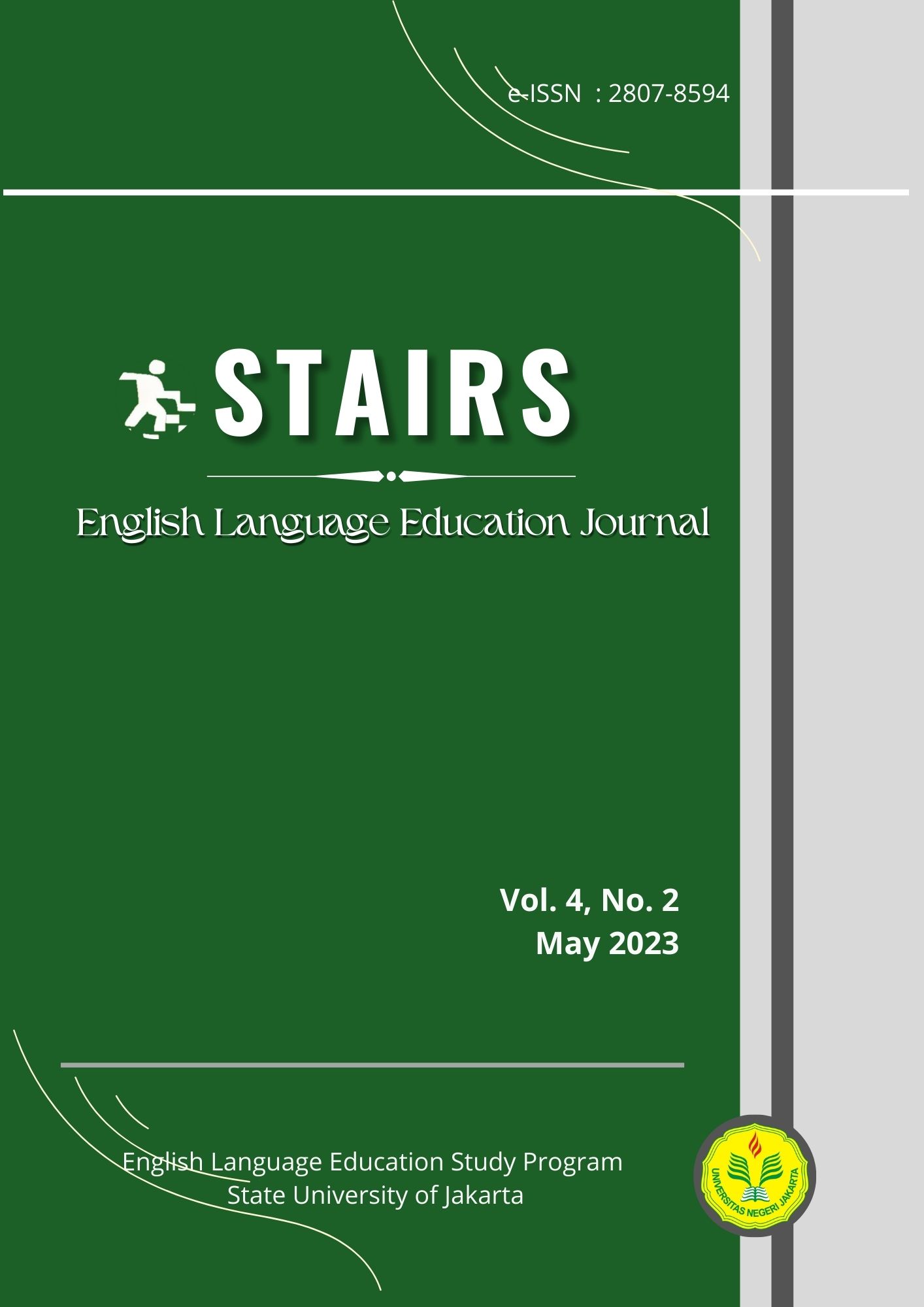Unveiling Creativity Elements in YouTube Narrative Videos for Ninth-Grade Junior High School Students
DOI:
https://doi.org/10.21009/stairs.4.2.5Keywords:
Creativity, Narrative Text, YouTube VideosAbstract
Creative narrative videos posted on YouTube have been proven to help students learn the narrative text and enhance students’ creativity toward making an excellent creative product. Along with the advantages, there are challenges and risks that teachers must consider since YouTube is an open-access video-sharing platform. This study aims to see whether narrative videos posted on YouTube meet creativity elements that can help ninth-grade junior high school students learn narrative text. This study used a qualitative method with content analysis to analyze fifteen narrative videos from three YouTube channels; Dongeng Kita, English Fairy Tales, and Gigglebox. The selected fifteen videos have been uploaded within the last seven years and are addressed to teenage viewers. Using the framework from D'Souza (2021), the findings show that the selected narrative videos fulfilled around 30% to 80% of the creativity elements. The audience immersive experience aspect, with a percentage of 45%, is the most dominant aspect of the narrative video's creativity elements. In contrast, the development and control aspect is the least in the creativity elements of narrative video, with a percentage of 25,5%. The narrative videos demonstrate diversity, a distinction or feature that distinguishes a narrative video from the previous version (narrative text). This study is expected to be a recommendation for teachers in choosing narrative videos on YouTube to support their teaching materials and simultaneously enhance students' creative thinking skills.
References
Amin, Y., Harmaini, F., & Tavriyanti, L. (2015). Teaching Reading A Narrative Text By Using Movie Maker At Junior High School. Kumpulan Artikel Wisudawan S1 Program Studi PING Periode ke 63 April 2015, 4(1). https://www.ejurnal.bunghatta.ac.id/index.php/JFKIP/article/view/4723
Anugerahwati, M. (2019). Integrating the 6Cs of the 21st Century Education into the English Lesson and the School Literacy Movement in Secondary Schools. KnE Social Sciences, 3(10):165. DOI. http://dx.doi.org/10.18502/kss.v3i10.3898
Creswell, J. W., & Creswell, J. D. (2018). Mixed Methods Procedures. In Research Design: Qualitative, Quantitative, and Mixed Methods Approaches.
D’Souza, R. (2021). What Characterizes Creativity in Narrative Writing, and How Do We Assess It? Research Findings from a Systematic Literature Search. Thinking Skills and Creativity, 42. https://doi.org/10.1016/j.tsc.2021.100949
Darvin, R. (2019). Creativity and criticality: Reimagining narratives through translanguaging and transmediation. Applied Linguistics Review. https://doi.org/10.1515/applirev-2018-0119
Ikmal, Halim, A., & Rusli, T.I. (2021). Using YouTube Videos to Enhance Students' Creativity on FLTM Class. Journal of Communication Studies, 6(1). https://pdfs.semanticscholar.org/7478/97b4afd249b0b1bb881343023fcd4fb8efee.pdf
Kampylis, P., & Berki, E. (2014). Nurturing Creative Thinking (Vol. 25). UNESCO International Bureau of Education. https://eric.ed.gov/?id=ED560535
Mayring, P. (2015). Qualitative Content Analysis: Theoretical Background and Procedures. 365–380. https://doi.org/10.1007/978-94-017-9181-6_13
Merjovaara, O., Nousiainen, T., Turja, L., & Isotalo, S. (2020). Digital Stories with Children: Examining Digital Storytelling as a Pedagogical Process in ECEC. Journal of Early Childhood Education Research, 9(1), 99-123. https://journal.fi/jecer/article/view/114125
Morat, B. N., Shaari, A., & Jafre, M. Z. A. (2017). Youtube Within ESL Classroom: Exploring an Instructor’s and Her Learners’ Experiences Concerning the Authenticity of Language and Technology Use. Malaysian Journal of Learning and Instruction, Special Issues, 173-196. 10.32890/mjli.2017.7802
Navarrete, E., Hoppe, A., & Ewerth, R. (2021). A Review on Recent Advances in Video-based Learning Research: Video Features, Interaction, Tools, and Technologies. In Proceeding of the CIKM 2021 Workshops, 3052(7). https://ceur-ws.org/. https://ceur-ws.org/Vol-3052/paper7.pdf
Neumann, M. M., & Herodotou, C. (2020). Evaluating YouTube Videos for Young Children. Education and Information Technologies. https://doi.org/10.1007/s10639-020-10183-7
Nurizmawati, C., Apriliaswati, R., & Arifin, Z. (2015). The Use of Animation Video as a Media in Teaching Narrative Text. Jurnal Pendidikan dan Pembelajaran Untan, 4(3).
Pandian, A., Yi, L. J., & Baboo, S. B. (2020). Digital Storytelling: Engaging Young People to Communicate for Digital Media Literacy. Malaysian Journal of Communication, 36(1), 187-204. https://doi.org/10.17576/JKMJC-2020-3601-11
Prihatini, F., Prihatin, Y., & Sani, N. (2018). The Use of YouTube Videos to Develop Students’ Writing Skills in Narrative Text. English Focus, 2(1), 68. 10.24905/efj.v2i1.54
Rahimi, M., & Yadollahi, S. (2017). Effects of Offline vs. Online Digital Storytelling on the Development of EFL Learners’ Literacy Skills. Cogent Education, 4(1), 1-13. DOI.10.1080/2331186X.2017.1285531.
Serrat, O. (2010). Storytelling. Washington, DC: Asian Development Bank.
Shopia, K., Sabila, D., & Purnawati. (2022). Students’ Interest in Learning English through YouTube (A Case Study in Senior High School of Sekolah Alam Cikeas Bogor). STAIRS: English Language Education Journal, 3 (1), 10-18.
Yuyun, I, & Simamora, F.Y. (2021). The Use of Youtube to Support EFL Student's Listening Skills. ELLTER-J. 2(2). DOI: 10.22236/ellter.v2i2.7512



